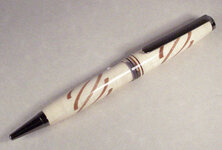Dvoigt
Member
I am looking at doing some segmenting and that would incorporate some yellow, white, blue, and green wood.
I'll need to get dyed wood for the green and blue (unless there are some abnormal trees out there that I don't know about).
I was assuming maybe Holly for white, but I'm concerned about that for segmenting it next to other colors, are there other options?
What about wood that is yellow in color, I know of Yellow Heart, but how yellow is that really?
Opinions?
Thanks,
Derek
I'll need to get dyed wood for the green and blue (unless there are some abnormal trees out there that I don't know about).
I was assuming maybe Holly for white, but I'm concerned about that for segmenting it next to other colors, are there other options?
What about wood that is yellow in color, I know of Yellow Heart, but how yellow is that really?
Opinions?
Thanks,
Derek

